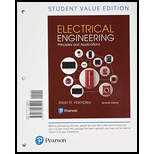
Concept explainers
It is necessary to reduce the voltage applied to an induction motor as the frequency is reduced from the rated value. Explain why this is so.
Answer to Problem 16.1P
To keep the ratio of voltage to frequency constant, it is necessary to reduce the voltage applied to an induction motor as the frequency is reduced from the rated value.
Explanation of Solution
Given Information:
It is necessary to reduce the voltage applied to an induction motor as the frequency is reduced from the rated value.
Consider the EMF equation for the induction motor:
where
Therefore, the induced EMF is directly proportional to flux and frequency:
Now, if the frequency is reduced, the magnitude of the induced EMF will also be reduced such that to maintain constant airgap flux.
Consider the applied voltage to the induction motor is V, such that, this applied voltage V is directly proportional to induced EMF E, i.e.,
Therefore, if the frequency is reduced to maintain the constant flux in the air gap, there must be a proportional reduction in the magnitude of the applied voltage.
If the applied voltage is not reduced in proportion to the frequency, it results in excessive motor currents which may cause damage to the motor. Due to this, losses increase, and therefore, the efficiency of the motor is reduced.
So, it is necessary to reduce the voltage applied to an induction motor as the frequency is reduced from the rated value.
Conclusion:
It can be concluded that it is necessary to reduce the voltage applied to an induction motor as the frequency is reduced from the rated value to maintain constant flux in the airgap.
Want to see more full solutions like this?
Chapter 16 Solutions
Electrical Engineering: Principles & Applications, 7th Edition
- Q3/ A/ Compare between de series and shunt generator. Q3/ B/ Briefly explain the commutating process in dc machine.arrow_forward1. The magnitude of various voltage drops that occur in an altemator, depends on...... load current 2. The power factor of an alternator depends on........load 3. The most suitable kind of rotor for turbo alternators which are designed to run at high speed is. 4. The frequency of voltage generated in an alternator depends on...arrow_forwardWrite a summary (points) about the stator resistance test of the squirrel cage induction motor .arrow_forward
- What is transient stability in power system?arrow_forwardQ2 Complete the answer : The rotor reactance of the three phase induction motor is varies with ................... of the rotor current.arrow_forwardFind all types of power losses (the second photo shows the types of power losses) The weight of the car is 800 Kg The weight of each person is 75 Kg You may assume any missing parameters you need in the design appropriately (e.g., the rolling-resistance-power, air-resistance-power, the DC motor's parameters, ....etc)arrow_forward
- Q3 Draw the equivalent circuit of a DC Motor, Separated Excited DC Motor and Compounded DC Motor. Label each component properly (a)arrow_forwardTwo identical 2000 kw alternator operates in parallel. The governor of the first machine is such that the frequency drops uniformly from 50 Hz at no-load to 48 Hz at full-load. The corresponding uniform speed drop of the second machine is 50 Hz to 47.5 Hz, What is the system frequency such that maximum load that can be delivered without overloading either machine?arrow_forwardV. List the different types of stray load losses in an induction motor.arrow_forward
- Q#3: Practically we observed that in single phase induction motor a capacitor is need for starting purpose. The question is that why we need the capacitor? And if the capacitor is not available then which device or element will use to start the single phase induction motor? Solution#3 (to be typed here by the student)arrow_forwarda) A sinewave is having a frequency of 50 Hz and instantaneous value of 150 Volts at 1.5 milli seconds. Find i) The maximum value of sinusoidal voltage waveform and ii) The value of voltage at 1.6 milli seconds. b) Determine the instantaneous equation for the voltage waveform shown in figure, if Vp=200 Volts, Time period is 15 milli seconds and =30 degrees. Upload your Answers steps in the "Final Answer Submission" Link provided in the Moodle. a) (i) Maximum value = a) (ii) Value of voltage at 1.6 ms = b) Angular frequency =arrow_forwardIV. What are the various losses in an induction motor? On what actors do they depend?arrow_forward
 Power System Analysis and Design (MindTap Course ...Electrical EngineeringISBN:9781305632134Author:J. Duncan Glover, Thomas Overbye, Mulukutla S. SarmaPublisher:Cengage Learning
Power System Analysis and Design (MindTap Course ...Electrical EngineeringISBN:9781305632134Author:J. Duncan Glover, Thomas Overbye, Mulukutla S. SarmaPublisher:Cengage Learning
